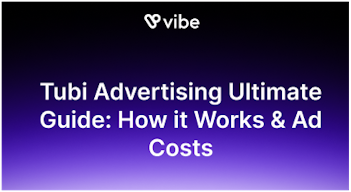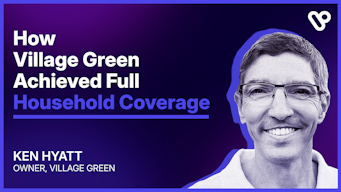How to Drive ROI with CTV Retargeting
As 2024 inches into Summer, Connected Television remains the fastest growing digital advertising channel by far, and brands of all sizes are presented with fresh opportunities for retargeting success. Vibe.co understands the challenges faced by agencies and brands navigating this relatively uncharted territory and aims to assist them in building performance-focused retargeting CTV (Connected Television) campaigns.
To maximize the effectiveness of programmatic retargeting, it is important to follow the latest best practices of an industry in flux and adapt to CTV’s evolving measurement paradigm: CTV advertising is breaking barriers in video marketing as it takes over the biggest screen in the home with granularly targeted content thanks to Demand-Side Platforms (DSPs) like Vibe.co that possess extensive mobile and TV audiences.
By incorporating retargeting and dynamic creative optimization in their video marketing strategies, brands can engage in cross-device storytelling campaigns that specifically target first and third-party audiences, while also incorporating geolocation, frequency capping, and dozens of targeting dimensions.
Retargeting is a proven, highly effective performance-driver in digital media, particularly in display ad units. Today, leading marketers are harnessing the same strategy in the realm of Connected TV advertising, capitalizing on its simplicity and growing power. Here’s how.
Retargeting on CTV - How it Works
You’ve probably already managed retargeting campaigns with other digital channels and seen encouraging results, but those results have likely plateaued (if not yet, then soon). While giant digital platforms like Meta remain unbeatable on reach, it has lost quite a bit of ground in reliably tracking conversion and attribution ever since Apple cut them off from mobile data collection last year.
In an earnings call last year, Meta leadership estimated their signal loss-related revenue drop around $10B. Yikes. Meta’s meltdown is shocking but not singular. Google is down 40% this year, Amazon 45%, and Snap 80%. Add the absolute insanity with X (né Twitter), and even the boldest marketer is wondering how to diversify their channels to mitigate a serious performance slowdown.
Enter CTV, a rapidly growing digital channel that can both enhance your existing digital campaigns and attract a whole new cohort of customers, especially when it’s deployed in partnership with a DSP with retargeting capabilities and a vast premium channel inventory. Showing relevant CTV ads to viewers who have recently visited your website (aka retargeting) is simple thanks to household IP tracking. You will just need to place a short tracking pixel on your site to gather visitor IP data that can then be used to deliver your ad to the same IP address on the streaming service of your choice.
CTV retargeting is so much more powerful than the video retargeting many of us were used to because it is launched in the most premium environment, full episodic player content, a.k.a. Streaming Apps. This device-agnostic and content specific strategy means that retargeting ads run on high-quality, premium networks such as ESPN+, Discovery, NBC, HBO Max, A&E. etc. Because these premium content apps are viewed across devices (TV, mobile, or tablet), brands have the ability to target users regardless of the device they are using, opening up the door to cross device targeting and tracking.
Say your brand or agency runs a multiplatform campaign that reaches 15 million people. Of those reached, 1.5% take action and visit your website. These 225,000 prospective (and already interested) customers become part of the TV retargeting audience segment. You can then develop a second touchpoint for this group, but instead of having a banner ad follow them from website to website (digital retargeting), you can reach these potential customers with rich, long-form TV commercials, woven into premium programming, with a lean-in viewing experience.
CTV Retargeting Best Practices
Retargeting is a highly effective customer acquisition and nurture strategy across digital channels for all kinds of businesses, from those with a long sales cycle like luxury or appliance brands to those looking to mitigate customer churn like subscription services. Its potential on Connected Television is particularly interesting as traditional channels reach their saturation point. When delving into CTV retargeting for the first time, we’ve seen optimal results when advertisers followed these simple best practices.
First, it is usually preferable for campaigns in their early stages to simultaneously implement prospecting and retargeting strategies. In our experience, brands and agencies who follow this approach often garner an average 3X Return on Ad Spend (ROAS) as well as valuable targeting insights. The two strategies will complement each other and provide a more full range of insights that will further facilitate campaign optimization.
Second, test early and often. Early test campaigns can be nerve wracking: when do we start making changes? when do we pull the plug? when do we start allocating more funds to a winning strategy? While it is important for advertisers to remain flexible and optimize as they go, allowing campaigns to run for a minimum of 90 days allows for comprehensive insights and data collection specific to CTV. During the initial stages, it is recommended to keep targeting wide to gather a broad range of insights from this emerging medium.
Due to a lack of measurement options in early CTV campaigns, success was once measured by low Cost Per Mille (CPM) and reach, but measurement accuracy has grown by leaps and bounds in the past few years (even in the last few months!) and advertisers’ focus has shifted to web page views and conversion as a more meaningful metric for optimization. Flexibility plays a vital role in campaign optimization, with real-time results serving as valuable feedback. To ensure success, advertisers need to partner with CTV ad platforms that have access to a large premium inventory, enabling vast audience reach even within a fragmented marketplace.
Beyond running parallel prospecting and retargeting campaigns simultaneously and leveraging premium inventory, here are some more tips to run an impactful retargeting campaign:
- Use higher frequency capping for retargeting campaigns because your audience has already shown interest so repetition won’t be as much of an issue.
- Leverage both 1st and 3rd party data
- Place a simple web traffic pixel on your website at least a week before campaign launch in order to have enough of an audience pool to retarget. We typically recommend a minimum of 15K monthly web visitors to make the investment worthwhile.
- Start with a wide target audience pool and narrow it down as results start rolling in.
- Set up all early campaigns for testing and don’t be afraid to experiment.
Following these steps will ensure measurable, scalable campaign results, no matter what industry you or your clients are in.
Two CTV Retargeting Use Cases
Hoodsly and Wahha Design are two Vibe.co clients who have worked to develop successful prospecting and retargeting CTV campaigns despite their vastly different business models.
Hoodsly first started working with Vibe.co to sell their line of premium, custom wood-range hoods with a Black Friday test campaign, closely followed by a Cyber Monday campaign that both yielded promising results.
Wahha Design, on the other hand, is a health-focused food delivery service that has been growing aggressively over the past few years. They needed a way to bring awareness to new brick and mortar clean eating cafes as well as their growing amount of meal kit pick up locations. At the same time, they need to remain top of mind for their existing customers in order to mitigate customer churn. Feeling confident in their existing PPC and PR campaigns, and frustrated with the long slog of SEO growth (who else can relate?!), they followed digital agency Wahha Design’s advice and gave CTV a try.
Hoodsly - Custom Home Appliance
Hoodsly’s main focus was to expand their reach with programmatic ad delivery, differentiate themselves from cheaper, big box options, by advertising on premium channels next to relevant content, and follow prospects further down the purchase funnel with retargeting.
First, the team built out their audience parameters, going wide with their geo-location targeting in order to capture as many new impressions as possible, but narrowing down the rest of their targeting by income (HHI > $150K) and web visits (retargeting).
They then developed two parallel campaigns that would target only HGTV, at a higher but valuable CPM on one hand and the top 5 channels with the highest daily view averages on the other, to ensure their dual goals of reach and performance could both be achieved.
Campaign setup was easy, especially thanks to Vibe.co’s robust CSM team and automatic bidding optimization. Ultimately, they settled on three ad sets, running simultaneously from Q1 2023 all the way through the end of Q3.
The Hoodsly team was able to A/B test their campaign creative to find their most compelling brand differentiators, track web conversions with Vibe.co’s pixel tracking codes (for visits, leads, and purchases), and target custom shopper profiles on over 500 premium channels.
The results? Hoodsly’s ROAS reached 409% and garnered 662K impressions for only $0.02 per view in under 2 weeks.
Wahha Design - Digital Marketing Agency
Wahha Design's clients - a healthy eating delivery company - already had a solid brand identity with some existing video assets for social and search, so all it took was some clever editing and they were off to the races, launching their first campaign in Mid-August, just in time for hectic back to school schedules and health resolutions.
They began with a robust prospecting campaign focused on their two most active targets: busy moms and health-conscious single men. They used Vibe’s simple targeting modules to hone in on the premium channels they knew their target audiences preferred and targeted their creative accordingly so viewers could recognize themselves in the ads.
Their mom-oriented ad delivered in channels like Hallmark, HGTV, Lifetime, and Bravo, while the creative focused on their male audience showed up on Fox News, ESPN, NFL, and AMC, among others.
By focusing their strategies on just a handful of targeting dimensions (channels and gender), Wahha Design was able to maintain their campaign CPMs at a staggeringly low $14 average, even on premium channels. In just a month and a half, ads garnered over 289K impressions with a $0.01 cost per view and a 98% VTR (View Through Rate).
Vast reach on a net new channel was a first goal, but for their next campaign, Wahha Design decided to draw a more direct connection between their CTV efforts and online purchases.
For their next campaign, Wahha Design used the simple pixel tracking tool under Vibe’s Measurement Module to gain more insight into their results while increasing the credibility of CTV marketing for both current and future clients. “The platform is so easy to use, it helped us experiment and drive for deeper results,” said Wahha Design CEO Blaxedell. This time around, they used insights from their Vibe.co dashboard to drive a multi-strategy campaign focusing on broad reach AND lower funnel retargeting.
The results? ROAS reached 860% after adding a retargeting strategy to their campaign, with $0.5 cost per page view and a bump in incremental reach.
Retargeting-Specific Creative Best Practices
One of the reasons CTV advertising has taken off exponentially over the last year is the prevalence of video marketing across channels. Advertisers for businesses and sectors of all sizes typically already had some video assets that just needed some clever editing before launching a national television campaign at digital marketing prices. For retargeting campaigns, however, it’s important to tailor your creative for a high-intent audience.
Some best practices for retargeting campaign creative include:
- Highlighting existing customers with testimonials and success stories. This audience will be looking for peer reviews - why not provide them yourself!
- Getting to the point quickly and repeating a single CTA several times to give your audience every chance to convert. Remember, they’re already half way there.
- Changing and testing your creative every month if possible, or every quarter at least. Because retargeting campaigns typically lead to action, it’s a perfect environment to pressure test different creative directions.
- Meeting new customer expectations: relevance, customization, and lower funnel outreach. According to a recent Deloitte study, 76% of consumers get frustrated when they are presented with irrelevant or non-customized ad content. Make the most of your CTV targeting options!



